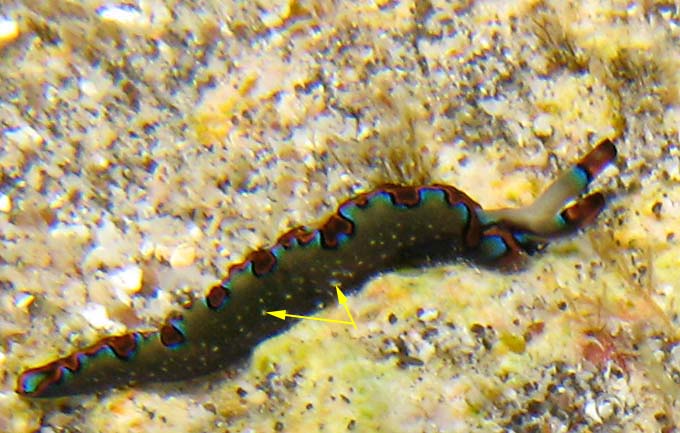This species has been observed on Reunion Island
Species characteristics : This sapsucker is turquoise bluish green. The undulating parapodial margin is a broad band of burnt orange, then a narrow line of black and a region of vivid blue reflective pigment. This coloration pattern is also present on the rhinophore and on the anterior margins of the foot. |

|
|
| Showing species characteristics... | Photo Philibert Bidgrain |
|
See more about : Sightening and mating periods
See more about : Thuridilla phylogeny by Gosliner 1995
See more about : Thuridilla undula variability in Southwest Indian ocean
Remarks :
Identification confirmed by Nathalie Yonow
This sapsucker was found with specimens of Sagaminopteron psychedelicum on Dysidea sp.
In these specimens we can observed between the burnt orange and the dark band a pale orange line (a little like in T. neona.... ), may be its a pattern variation for this species. We need other photos to confirm this hypothesis.
Synonymous : (according Worms)
- No other name
Bibliographic data :
A typically shaped thuridillid, long and thin, tapering posteriorly, and with a pair of rolled rhinophores anteriorly. The rhinophores are ¼ total body length.
In T. undula the orange, blue and black markings on the rhinophores are transverse bands
T. undula is similar in colour to T. neona. Both have a turquoise body with burnt orange, black and blue undulating parapodial bands. However T. neona has additional bright orange markings on the parapodia, anterior margin of the foot and the rhinophores. In T. undula the orange, blue and black markings on the rhinophores are transverse bands, while in T. neona they are diagonal.
T. undula is even closer in colour to T. lineolata, the main difference being that the colour bands at the parapodial edge undulate in T. undula and are parallel to the edge in T. lineolata.
Comparative data of the five Thuridilla with black, orange and blue margin found in our area...
T. undula
Parapodial margin
Narrow white edge enlarged at regular intervals, then a narrow stripes of orange, black, pale blue, and black.
Thin brownish black edge, then a broad band of yellow-orange, and an irregular band of black. In the spaces between the blackish extensions are bright blue
Black edge followed by lines of orange, black and narrow iridescent blue
Bright yellow-orange edge, followed by a thin black line and a diffuse broad light blue to blue green band.
Broad burnt orange edge, followed by lines of black and vivid blue
Head
Opaque white pigment with sometimes orange marks
Blue with a centrally placed Y-shaped opaque white patch
Dark brown to black
Black to dark blue
Black and reflective blue pigment.
Rhinophores
They have opaque white pigment with sometimes orange marks
The tips of the rhinophores are blackThe base are whitish to pale blue. At the tips are bands of blue, black, orange-yellow and black.
Not observed in our specimensThey are dark brown to black
The apical half has opaque white pigmentThey are light blue except for the tip which is dark-blue
The base are turquoise bluish green. At the middle are narrow bands of blue and black. The apex is orange
Body
Orange or light to dark green
Translucent green with scattered opaque white spots
Dark brown to black
Black to dark blue
Turquoise bluish green
Anterior margin of the foot
It has orange, black, blue and black lines
It has black, orange-yellow , black and blue bands
It has black, orange and blue lines .
It hasn't blue and orange lines
It has orange, black and blues bands.
References :
Bill Rudman Seaslug site : Sea Slug Forum : Thuridilla undula
Publications :
Gosliner, T.M. (1995) The genus Thuridilla (Opisthobranchia: Elysiidae) from the tropical Indo-Pacific, with a revision of the phylogeny and systematics of the Elysiidae. Proceedings of the Californian Academy of Sciences 49(1) : 1-54.
Jensen, K.R. (2007). Biogeography of the Sacoglossa (Mollusca, Opisthobranchia). Bonner Zoologische Beiträge. 55: 255–281.
Other photos of Thuridilla undula :
 |
Sophie Darnis Reunion, "Maison verte" at Saint Leu, 30 April 2006, size : 7-8 mm |
Sophie Darnis Reunion, "Cirque des Aigrettes" at Saint Gilles, 10m, 2 December 2007, size 10-12 mm
|
 |
 |
Philibert Bidgrain Réunion, "Trou d'eau" at Saint Gilles, less 1 m, 6 October 2010, size 15-18 mm A specimen with a very wavy margin parapodial |
Philibert Bidgrain Réunion, "Trou d'eau" at Saint Gilles, less 1 m, 6 October 2010, size 10-12 mm
A specimen with small white dots on the sides of parapodia .... like Thuridilla indopacifica
|  |
 |
Philibert Bidgrain Réunion, "Trou d'eau" at Saint Gilles, less 1 m, 11 October 2010 A specimen with a extra whitish band near the tip of the rhinophore |
More photos from Indian Ocean
See more about : Thuridilla phylogeny by Gosliner 1995
See more about : Thuridilla undula variability in Southwest Indian ocean
Maldives, Thuridilla undula, at Felidhoo Atoll, by Nathalie Yonow
Reunion, two Thuridilla undula crawling on the substrate, at Trou d'eau, by Philibert Bidgrain